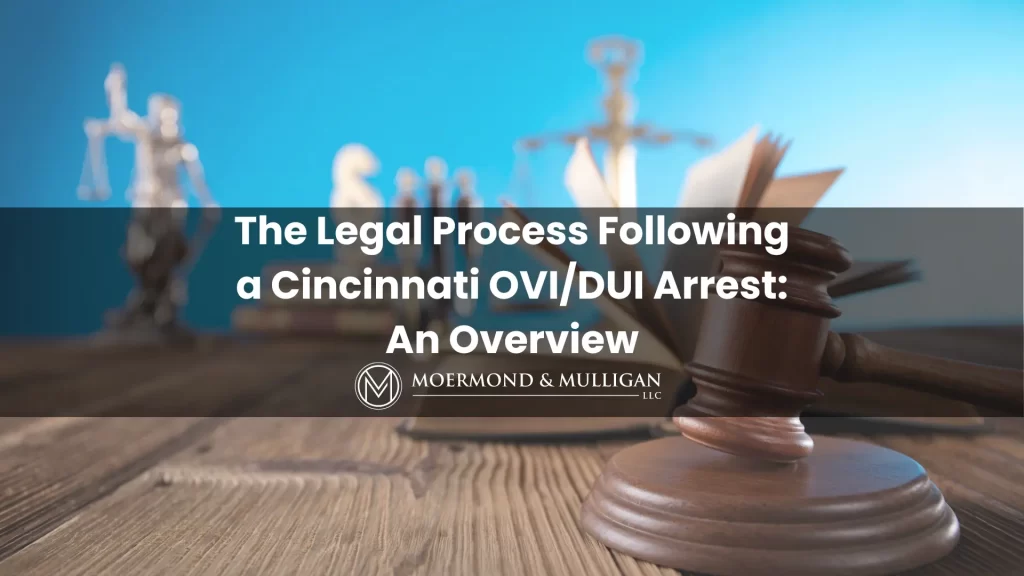Posted on Friday, July 21st, 2023 at 9:11 pm

Navigating the complex labyrinth of the legal process following a Cincinnati OVI/DUI arrest can be a daunting prospect. Understanding the trial procedures and what you can expect from the legal process following an arrest for Operating a Vehicle Impaired (OVI, sometimes called DUI) can allay some of your natural concerns and prepare you for the road ahead.
The Arrest Process
In Cincinnati, law enforcement initiates the OVI/DUI arrest process with a traffic stop, potentially followed by:
- Arrest: The officer will administer a field sobriety test and/or a breathalyzer test. If the driver fails the test or refuses to take it, the officer can arrest them for OVI/DUI. The police read the arrestee their rights and then transport them to the police station.
- Booking: Upon arriving at the station, officers book the arrestee. This process includes recording personal information, details of the alleged offense, fingerprinting, and confiscation of personal belongings. In some cases, officers may conduct another breath, blood, or urine test.
- Bond/Bail: Following booking, a bond may be set by a judge, allowing the defendant to be released from custody until their court appearance. The amount of this bond can vary greatly depending on the individual’s criminal history and the specifics of the current case.
Arraignment and Plea
After an arrest for an OVI/DUI in Cincinnati, the next step in the legal process is the arraignment. The arraignment serves as the formal reading of the criminal charging document in the presence of the defendant, marking the beginning of the court proceedings.
At this stage, the court officially informs the defendant of the charges. They also receive reminders about their constitutional rights, like the right to counsel. Defendants should ideally secure legal representation before the arraignment, as it is highly recommended. Legal counsel from an OVI/DUI attorney like those at Moermond & Mulligan, LLC can provide invaluable guidance during this critical phase.
After reading and understanding the charges, the defendant enters a plea. There are typically three options for the plea: “guilty,” “not guilty,” or “no contest.” A guilty plea is an admission to the charges, and the court will move directly to sentencing. In some cases, defendants will agree to a plea bargain, pleading guilty in exchange for reduced sentencing or other considerations.
A not guilty plea denies the charges, leading to the scheduling of a pretrial hearing or a trial date, while a no contest plea means the defendant does not contest the charges. It’s similar to pleading guilty but without making an actual admission of guilt. The judge will then decide the case based on the presented facts.
Your choice of plea can significantly impact the outcome of your case, making it crucial to discuss this decision with your attorney. Your attorney will analyze the specifics of your case, the evidence at hand, and help you understand the potential implications of each plea option.
Discovery and Case Evaluation
Next comes the discovery process, the procedure by which both the prosecution and defense share information about the case. This includes the evidence they plan to present, witness lists, and police reports. In an OVI/DUI case, this often encompasses the officer’s observations at the scene, results from field sobriety tests, breathalyzer or chemical test results, and possibly dashcam or bodycam footage. The goal is to ensure all parties have a clear understanding of the facts before going to trial.
 With the acquired information from discovery, the defense attorney will conduct a comprehensive evaluation of the case. This stage involves reviewing every aspect of the evidence, looking for potential weaknesses in the prosecution’s case, and identifying any procedural errors that may have occurred during the arrest. For example, they might ask if the officer had a valid reason for the initial traffic stop or if they properly conducted the field sobriety tests.
With the acquired information from discovery, the defense attorney will conduct a comprehensive evaluation of the case. This stage involves reviewing every aspect of the evidence, looking for potential weaknesses in the prosecution’s case, and identifying any procedural errors that may have occurred during the arrest. For example, they might ask if the officer had a valid reason for the initial traffic stop or if they properly conducted the field sobriety tests.
Pre-trial Motions
Following discovery and case evaluation, pre-trial motions may come into play. Before trial, the defense or prosecution submits legal requests to guide the trial’s scope and direction.
One of the most common motions in OVI/DUI cases is the motion to suppress evidence. If the defense attorney believes that certain evidence was obtained illegally or improperly — for example, if they suspect that the arresting officer did not have probable cause to stop the defendant’s vehicle or did not administer field sobriety tests correctly — they might file a motion to suppress that evidence. If granted, the suppressed evidence cannot be used by the prosecution during the trial.
The officer may proceed with an arrest for OVI/DUI when the driver fails the test or refuses to participate in it. This could be due to insufficient evidence, procedural mistakes, or violations of the defendant’s rights.
Want to Learn More?
Facing charges over DUI/OVI in Cincinnati can be overwhelming, but you don’t have to do so alone. Contact Moermond & Mulligan, LLC, online or by calling (513) 421-9790, to speak with a Cincinnati OVI defense lawyer for free.
Related Posts: